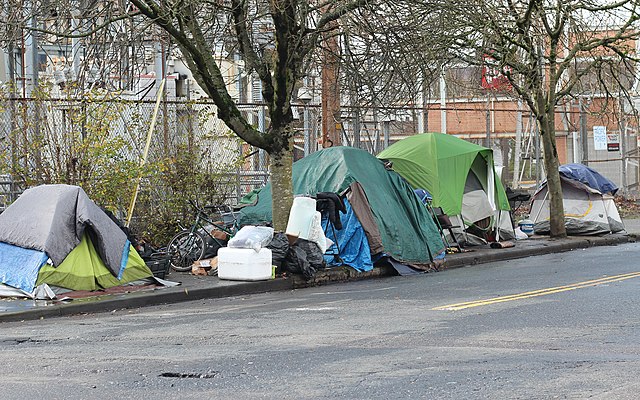Oregon’s governor, Tina Kotek, knows what her priorities are. With her endorsement, the state is spending billions of dollars to deal with its housing shortage. Thanks partly to that housing shortage, homeless camps can be found all over the state, from Portland to tiny Sisters, a city of 2,000.
“Unmanaged” homeless camp in Portland. Photo by Graywalls.
Some of that money is supposed to be used to create managed homeless camps, where homeless people supposedly will have access to “food, hygiene, litter collection and treatment for mental health and substance abuse.” However, Governor Kotek recently informed officials in Bend, central Oregon’s largest city, that they would not be allowed to have a managed homeless camp outside of the city’s urban-growth boundary. “We must exhaust every possible option within the UGB for shelter sites,” she said.
When Bend established its growth boundary in 1981, it was a town of 17,000 people. By 2010, the city had grown to 80,000 residents, but when it proposed to expand its growth boundary by 40 percent, the expansion was rejected by the state. In 2016, the city tried again, proposing an expansion of slightly more than 10 percent even though the city’s population of 100,000 is well over five times what it was when the boundary was first established. That small increase was accepted, but all of that land has since been developed or is spoken for, so the city and Deschutes County have few options for managed homeless camps.
Statewide, only about 1.3 percent of land is inside of an urban-growth boundary. On most of the land outside of the boundaries, people aren’t allowed to build even one single-family home unless they own at least 80 acres, actually farm it, and (depending on soil productivity) earn at least $40,000 to $80,000 a year from farming it. Most Oregon farms don’t earn $40,000 a year, much less $80,000.
The growth boundaries, of course, are the reason why Oregon housing is expensive. Governor Kotek gives the proper lip service to “affordable housing” and helping homeless people. But, given the one option that would making housing truly affordable — allowing development outside of the growth boundaries — Kotek’s knee-jerk response is “no.” Clearly, a misconceived idea of environmental protection takes precedence over having an affordable housing market.









Long ago I wrote how low iQ groups cannot sustain a democracy or beneficial form governance.
Despite federal, state, county, local government. Self Governance in form community maintenance and observation keep neighborhoods in decent state.
Geopolitical stability and personal freedom cannot survive average IQ’s below 90.
The average US Black IQ is 87, but includes blacks with significant white ancestry (25% average). Among the commiserated black underclass the average IQ is closer to 75-85. Hispanic iQs are 86.
Drug addict iQ’s are in the gutter. Drug use for prolonged times, damages brain to point memory, cognitive output decline.
Brain development continues til mid 20s Which is WHY adolescent drug use 15-20 is so detrimental to urban youth. It’s bad enough average black iQ is 87, drug use knock it down.
The homeless crisis can not be solved, because it’s not a “homeless crisis” it’s a cognitive and use crisis. You take physically able, but mentally impaired people. Drug use basically turns them into border line retarded.
They cant work outside scope basic physical labor.
And even then… they require constant supervision round the clock….
Cost of Rehab in 2023
Drug Detox (30-day): $250–$900 per day
Outpatient Care (3 months): $1,450–$11,000
Intensive Outpatient (30 days): $3,100–$10,000
Residential Treatment (varies): $5,300–$80,000
Treating 10,000 patients costs taxpayers a minimum 300 million dollars. After which they’ll have to be housed and monitored. THey’re prisoners of their own damaged brains……